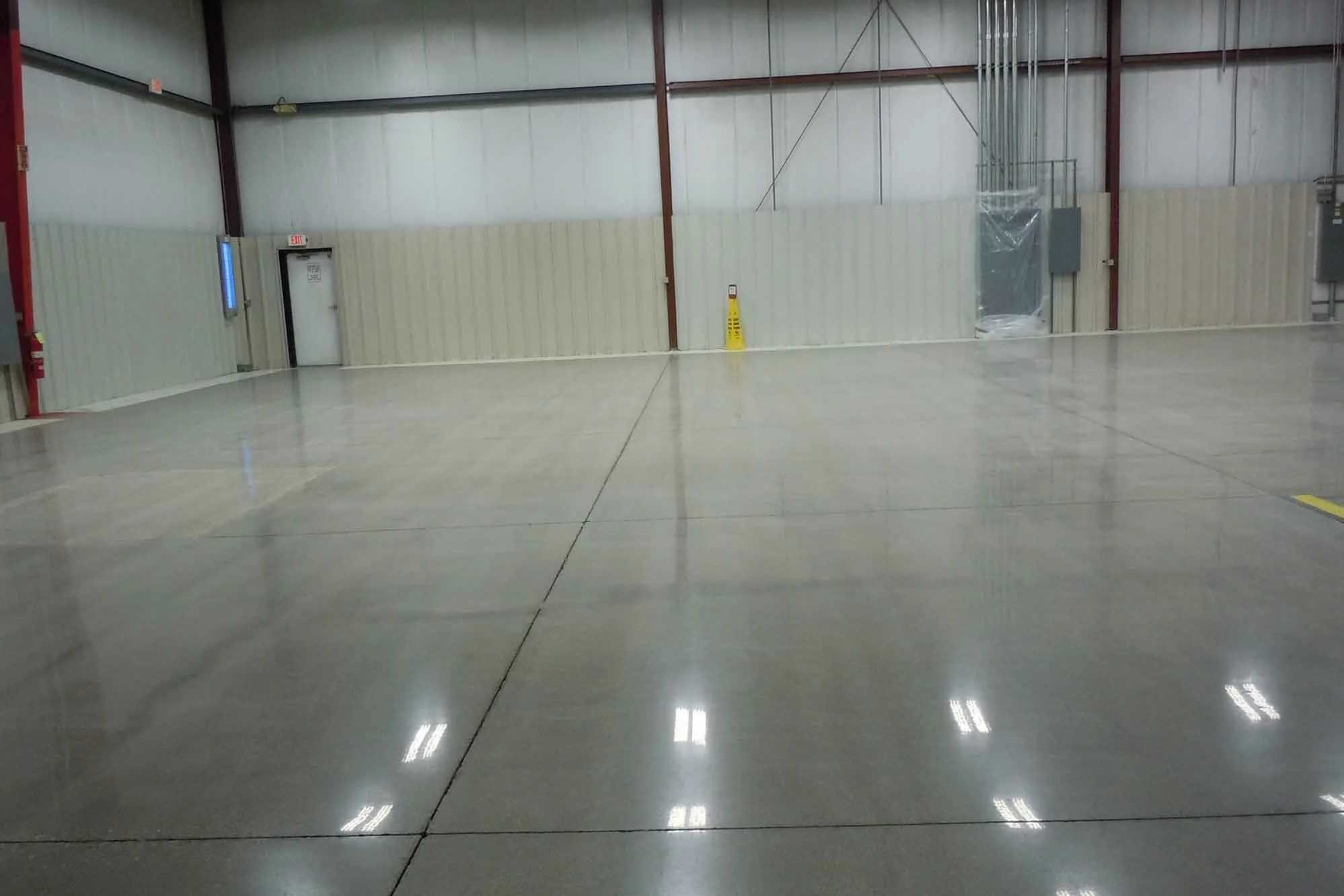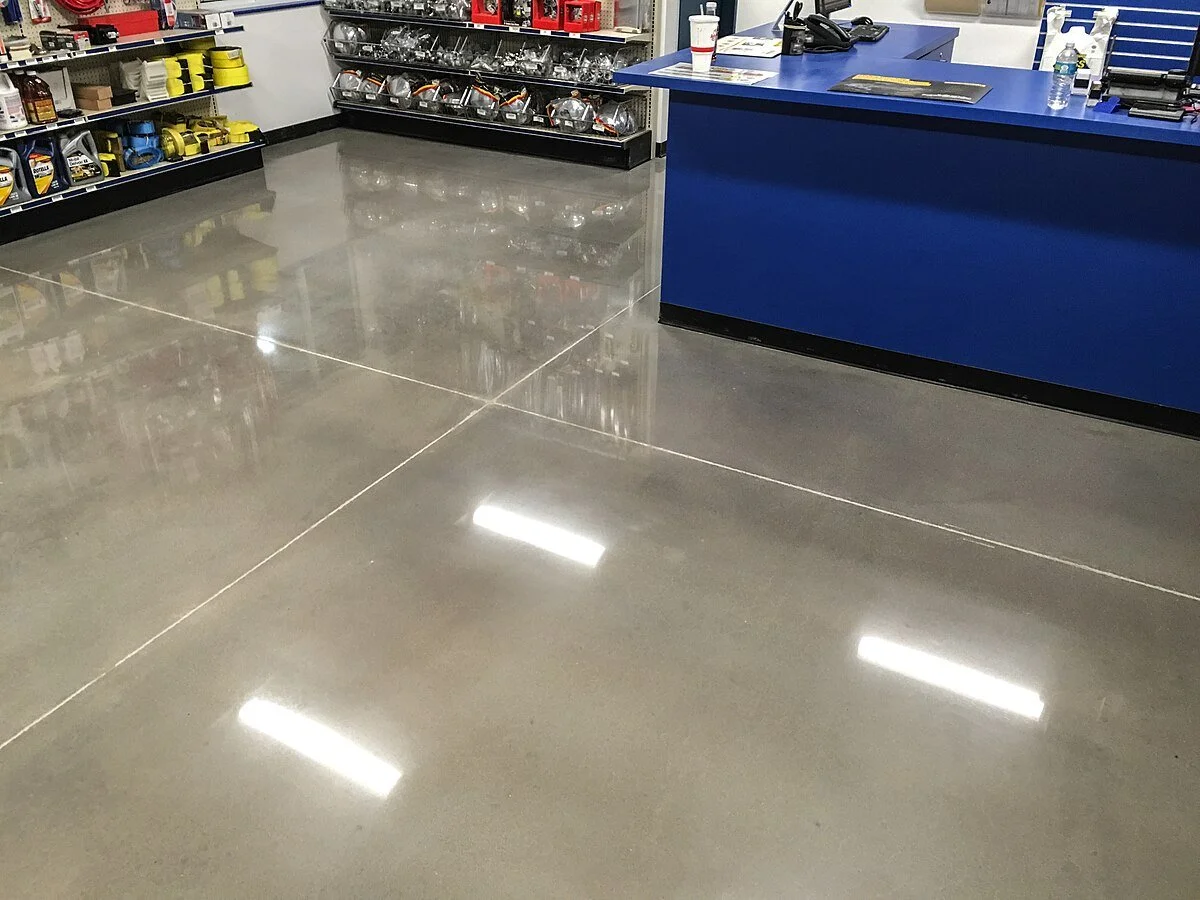
Tough. Clean. Low-Maintenance.
Polished concrete systems offer a hard, durable, and dust-proof surface designed for industrial environments. They enhance the performance of your existing concrete slab, reducing maintenance while improving safety, light reflectivity, and appearance — all without adding coatings or overlays.
What is a Polished Concrete System?
Polished concrete is a mechanically refined concrete surface achieved through grinding, densifying, and polishing the existing slab to a desired sheen. The process uses progressively finer diamond abrasives to smooth the surface while a densifier chemically hardens and seals the concrete from within.
Unlike coatings or overlays, polished concrete is not a topical system. It’s a permanent finish that resists wear, eliminates dusting, and requires minimal maintenance. It’s ideal for industrial settings due to its durability, longevity, and cost-effectiveness — especially in facilities with forklift traffic, manufacturing, or storage.
Why chose a Polished Concrete System?
Extremely Durable
Withstands forklifts, carts, and abrasion without chipping, peeling, or delaminating.Low Maintenance
No waxes or coatings required — just regular dry and wet cleaning.Dust-Proof and Sealed
Densification seals pores and eliminates concrete dusting common in industrial slabs.Improves Safety and Visibility
Increases light reflectivity up to 30%, reducing lighting costs and improving work zone visibility.Cost-Effective Over Time
Minimal maintenance, no reapplication, and a long lifespan make polished concrete one of the most affordable lifecycle flooring systems.Environmentally Friendly
No VOCs, low energy usage, and no additional material waste.Slip Resistant
Even in glossy finishes, polished concrete can meet OSHA slip resistance requirements with proper tooling and finishes.
Best Applications
Polished concrete is ideal for industrial environments that require a hard, dust-free, and low-maintenance floor capable of withstanding heavy traffic and daily wear.
Industrial
Warehouses and distribution centers
Manufacturing and assembly plants
Automotive and aircraft maintenance bays
Logistics and fulfillment centers
Storage and shipping facilities
Food and beverage production (dry zones)
Retail stockrooms and back-of-house areas
Government and municipal maintenance garages
Utility plants and water treatment facilities
Cannabis cultivation and grow rooms
Our Process (How We Install Polished Concrete Systems)
1. Site Evaluation and Slab Testing
We begin with a full diagnostic evaluation of the slab, including age, structural integrity, flatness, hardness, and porosity. We also conduct moisture readings and contamination tests to ensure compatibility with industrial polishing. Based on these findings, we determine the ideal densifier chemistry, tooling progression, and polishing schedule to meet traffic, durability, and compliance needs.
2. Heavy Grinding (Initial Cut)
Using high-torque industrial grinders with 16–40 grit metal-bond diamonds, we aggressively remove surface coatings, high spots, laitance, and embedded contaminants. This deep cut prepares the slab for densification while allowing control over aggregate exposure — from cream to full stone reveal. All perimeter edges are hand-tooled to match main field cuts.
3. Joint and Crack Repair
Before further polishing, all control joints, cracks, and surface defects are filled with semi-rigid epoxy or polyurea fillers designed to flex with slab movement. Structural voids, spalls, and edge breakouts are patched and honed flush. This repair stage is crucial for clean, uniform reflection and long-term structural stability under industrial traffic.
4. Intermediate Grinding
We advance through finer metal-bond grits (typically 60–100 grit) to refine the surface, removing tool marks from the initial cut. This step begins to close the surface while controlling porosity and prepping for densifier absorption.
5. Densifier Application
A high-performance lithium or potassium silicate densifier is applied across the entire surface. This chemically bonds with free lime in the concrete to create a harder, more abrasion-resistant surface. Densifiers also reduce porosity, increase chemical resistance, and improve light reflectivity. Proper dwell time and saturation are key for maximum penetration.
7. Optional Stain Guard Application
In heavy-use environments, we apply a penetrating stain guard or lithium-based guard finish to boost resistance to oil, grease, chemicals, and forklift tire marks. This step helps maintain appearance under extreme wear and simplifies maintenance protocols.
6. Resin Polishing Steps
We polish using resin-bonded diamond abrasives in progressive stages, typically from 100 grit up to 800–1500 (or 3000 depending on spec). The final gloss level is matched to client needs (matte, satin, or high-gloss). Each polishing stage includes vacuuming and inspection to ensure uniformity, clarity, and reflectivity across the entire slab.
8. Final Burnishing (If Applicable)
For enhanced clarity and stain repellency, the floor may be burnished with a high-speed propane or electric burnisher. This thermal friction process tightens the slab surface, increases gloss, and helps lock in long-term durability for 24/7 industrial use.

Strength from the Ground Up
Polished concrete is more than just clean and shiny — it’s a hardened, sealed, and cost-efficient surface built to last in the toughest industrial environments.
Let’s turn your existing slab into a high-performance floor — without shutdowns or coating failures.

